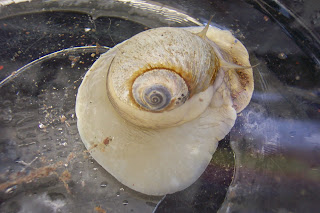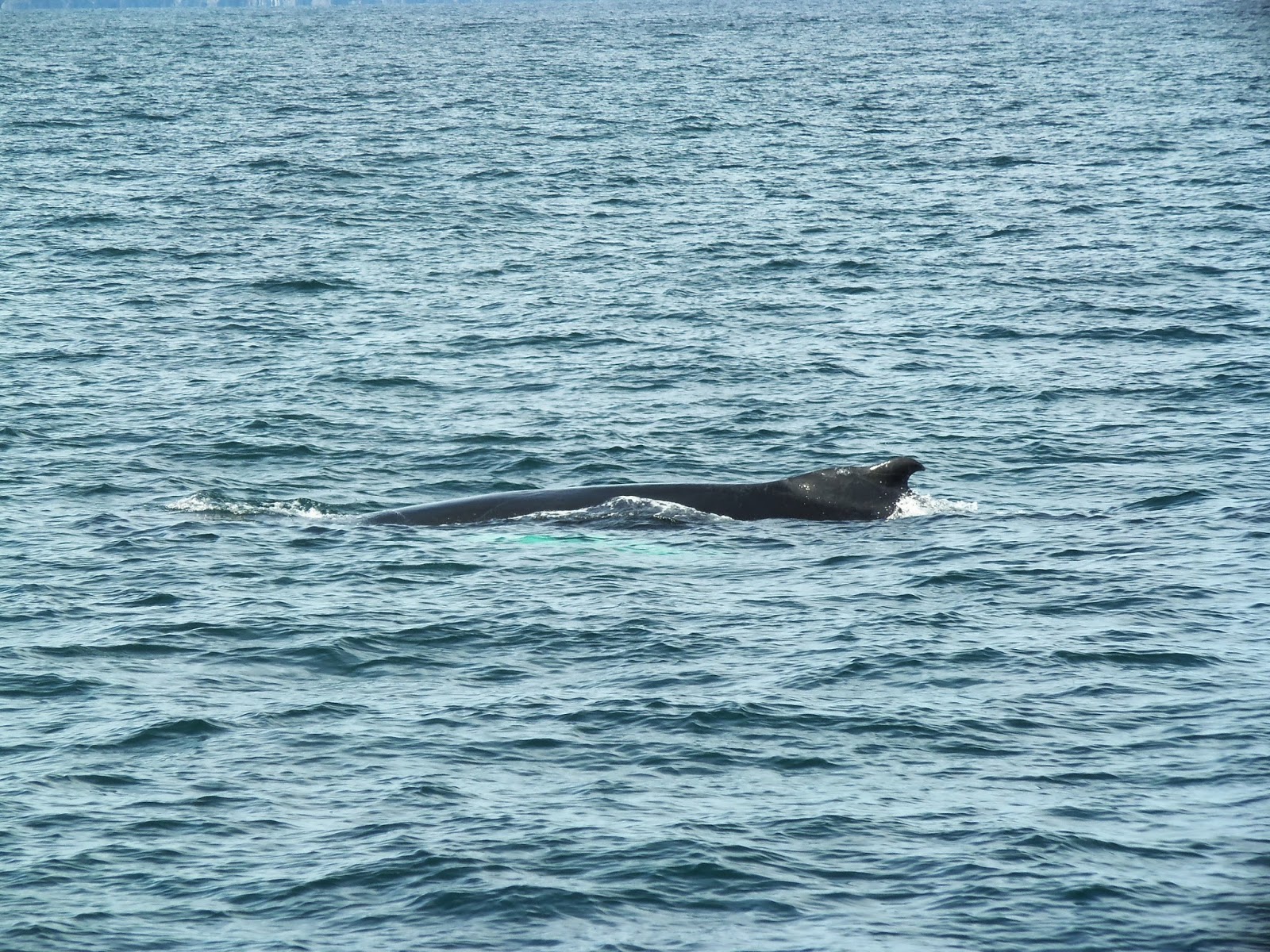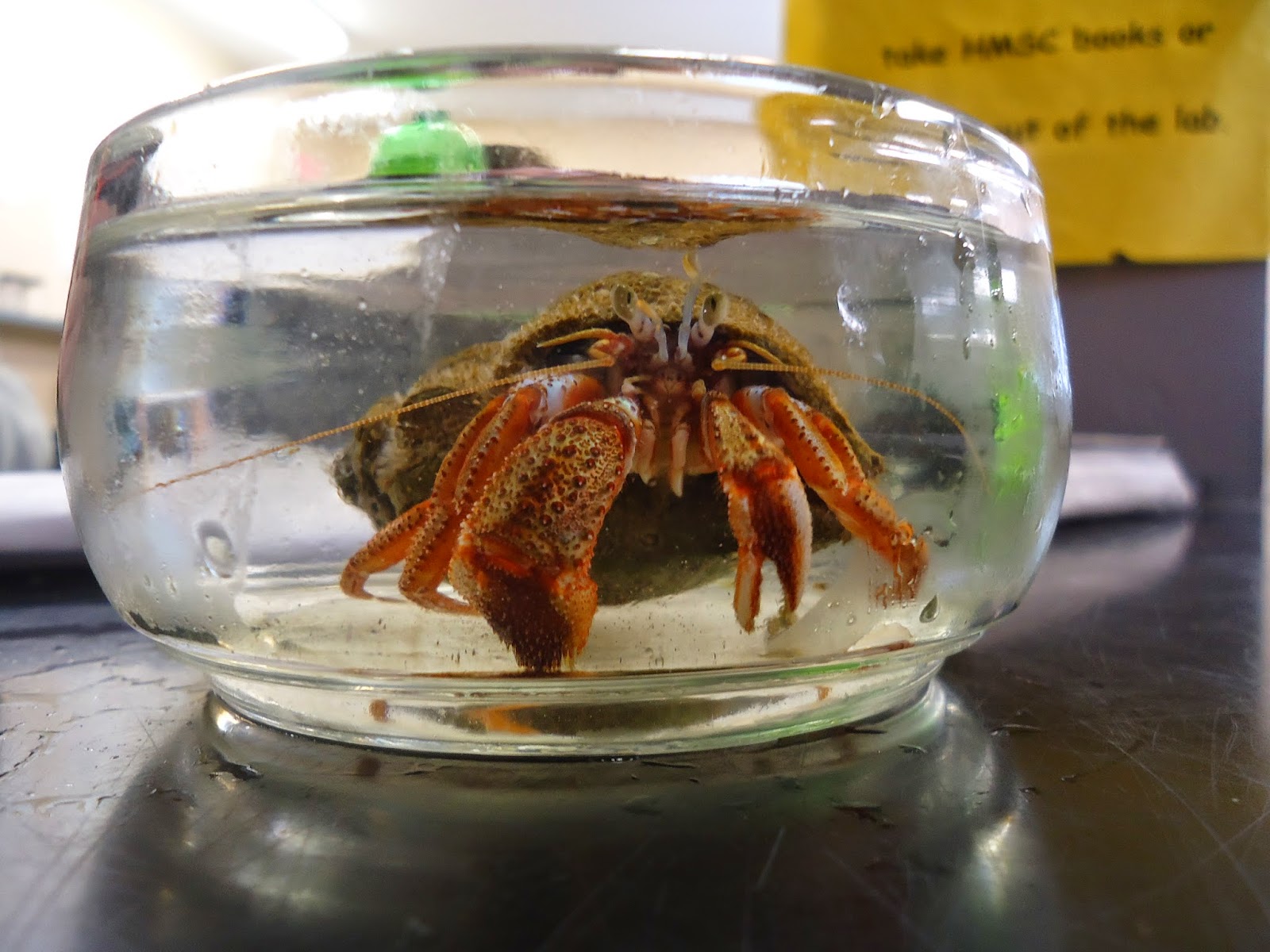Today we welcomed 27 homeschool students to the aquarium to learn about whales.
The oldest students joined me in the lab first to explore if size affects how much heat you lose. We compared 'mice' and 'whales' during our experiment and were surprised to find the smaller animals lose heat faster because of surface area.
The Kindergarten to Grade 2 students started their exploration of whales by looking at porpoise and dolphin teeth, as well as baleen from a number of different whale species. Then they conducted an experiment testing teeth vs. baleen at catching plankton and fish. The group concluded that teeth were only good at catching fish but the baleen could collect both. The final activity was to make a humpback whale food chain craft.
The Grade 3 to 5 group were a little grossed out by their experiment using olives, shortening and staples to test whale buoyancy. They were troopers through and I think they enjoyed the lab despite all the 'ewwws'. Now they will always think of whales when they see an olive!
Tuesday, 25 November 2014
Thursday, 13 November 2014
Mollusc Diversity
Molluscs are a group of invertebrate animals that have soft bodies and generally a 'head' and 'foot' region. Often the body is covered by shells or plates. Molluscs can be found in marine, freshwater and terrestrial environments. Below are a sampling of the molluscs that students find with us while exploring the intertidal and subtidal habitats around St. Andrews.
Cup-and-saucer limpets (Crucibulum striatum) stuck to rocks and shells brought up from the ocean bottom.
Slipper limpets (Crepidula fornicata) are often found stacked. The largest one on the bottom is female and the smaller ones on top are male. If the female on the bottom dies the largest male will become a female.
The underside of the slipper limpet showing the 'deck' from which the animal gets its common name.
Tortoiseshell limpet (Acmaea testudinalis) on the move in the intertidal zone.
Smooth periwinkles (Littorina obtusata) are usually found amongst knotted wrack on the beach.
Smooth periwinkles can be a variety of colours.
Note how well camouflaged the smooth periwinkles are to match the reproductive receptacles and air bladders of the seaweed.
Rough periwinkles (Littorina saxatilis) are found in the high intertidal zone.
Common periwinkles (Littorina littorea) are the largest and most abundant periwinkle in Passamaquoddy Bay. Their original habitat was Europe but they have been here for over 100 years.
Moon snail (Lunatia heros) are found on muddy beaches and can grow quite large.
The moon snails leave egg collars on the beach.
The spotted moon snail (Lunatia triseriata) is a smaller species than the one above and can be distinguished by bluish or purplish spots on the shell.
The mud dog whelk (Nassarius obsoletus) is found on rare occasions in the intertidal zone.
Waved whelks (Buccinum undatum) and their masses of egg capsules are pulled up in the scallop drag.
Dogwinkles (Thais lapillus) are carnivorous and prey on other intertidal animals such as blue mussels, periwinkles and barnacles as they are doing in this picture.
Dogwinkle eggs as found under a rock on the beach.
The ten-ridged whelk (Neptunea decemostata) is a large snail found on the ocean floor.
The Stimpson's whelk (Colus stimpsoni) is a rare find in the scallop drags.
The rough-mantled nudibranch (Onchidoris bilamellata) is a sea slug.
These shell-less molluscs lay their eggs in ribbons on the underside of rocks in the intertidal zone.
The red-gilled nudibranch (Coryphella rufibranchialis) is a beautiful and delicate sea slug found in the lower intertidal zone.
This scallop (Placopecten magellanicus) is showing off its many eyes.
Scallops are fished commercially in this area and are a favourite at the local restaurants.
Blue mussels (Mytilus edulis) attach tightly to each other using byssal threads, called the beard by mussel lovers.
The horse mussel (Modiolus modiolus) is much larger than the blue mussel and has a brown, flaky covering. Not a commercial species.
The waved astarte (Astarte undata) is a small bivalve we pull up in the scallop drag.
The northern cardita (Cyclocardia borealis) is another small bivalve that lives on the bottom.
The quahog (Mercenaria mercenaria) is easily identified by the purple stain in the shell. Locally, these can only be found in Sam Orr Pond. The latin name is derived from the fact that these shells were used in making Native American money or wampum.
The black clam (Arctica islandica) lives on muddy bottoms.
Soft-shelled clams (Mya arenaria) are dug by clam diggers on the many muddy beaches in our area.
This picture shows the siphon openings of the soft-shelled clam; all that you see when the clam is buried in the mud.
The macoma clam (Macoma balthica) is a small bivalve with a pink interior.
Macoma clam holes on the beach.
The razor clam (Ensis directus) burrows deeply on muddy bottoms in the subtidal zone. Its long foot is used to burrow and swim.
Short-finned squid (Illex illecebrosus) swim in large schools and die after spawning.
Long-finned squid (Loligo pealei) eggs found on the shore.
This octopus (Bathypolypus arcticus) is distinguished by the warty horns above its eyes. They are occasionally collected in our fish trawls in deep water.
Wednesday, 12 November 2014
Whale dorsal fins
Students that take part in field courses with us in the summer and fall usually get a chance to go whale watching in the Bay of Fundy. Some of the whales that frequent our area include minkes, humpbacks, fin whales, northern right whales, harbour porpoises, and atlantic white-sided dolphins. Below are some pictures of the dorsal fins of these species to aid in identification in the field.
Northern right whale = no dorsal fin
Humpback whale = dorsal fin sits on a large hump
Fin whale = curved dorsal fin very far back on body
Minke whale = curved dorsal fin far back on body
Harbour porpoise = small, triangular dorsal fin
Atlantic white-sided dolphin = large, curved dorsal fin
Thursday, 6 November 2014
Arthropod diversity
Arthropods are a group of animals that share the common characteristics of having an exoskeleton (skeleton on the outside of the body), a segmented body, bilateral symmetry and jointed legs (arthritis affects joints; arthropods have joints). Below are some pictures of arthropods we commonly find while exploring Passamaquoddy Bay with students.
Sea spiders (Nymphon stromi) from the subtidal zone.
Water flea in the plankton sample.
A copepod in the plankton sample.
These are eaten by North Atlantic Right Whales.
Northern rock barnacles (Balanus balamoides) found on the beach.
Crenate barnacles (Balanus crenatus) are a large barnacle found in the subtidal zone. In this picture they are releasing larvae.
An amphipod (Corophium volutator) found in the mud flats.
Sideswimmers (Gammarus sp.) are frequently found squiggling under seaweed and rocks on the beach.
Skeleton shrimp (Caprella sp.) can be found in great numbers on tunicates and sponges pulled from the bottom of the bay.
Skeleton shrimp on a sea star arm as seen through the microscope.
Armoured shrimp (Sclerocrangon boreas) come up in our scallop drags.
Boreal red shrimp (Pandalus sp.) collected in our fish trawls.
They are edible.
The iconic arthropod of the maritimes, the lobster (Homarus americanus).
Acadian hermit crabs (Pagurus acadianus) are a delight to find in our scallop drags.
The hairy hermit crab (Pagurus pubescens) is occasionally found in the bay.
The toad crab (Hyas araneus) is collected from the bottom by our scallop drag.
Rock crabs (Cancer irroratus) are a crab that is fished commercially.
European green crabs (Carcinus maenas) are an invasive species that have been in North America since the 1950s. They are the most commonly found crab on our beaches.
Subscribe to:
Comments (Atom)
































































